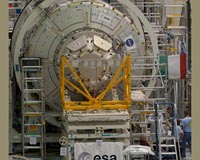 |
Moscow, Russia (SPX) Feb 08, 2010 Approach to the space station, its fly-around, stationkeeping and docking were performed in automatic mode. The initial contact with the docking port on the instrumentation and propulsion compartment of the Zvezda Service Module of the ISS Russian Segment (RS) occurred at 07:26 Moscow Time. The crew of Expedition 22 to ISS working on-board the space station monitored the process of rendezvous and docking. All the dynamic operations were performed by mission control specialists under the supervision of the Technical Management (The Technical Manager is the President and Designer General of the S.P. Korolev RSC Energia V.A. Lopota). Present at the Mission Control Center near Moscow (MCC-M) during the final operations of the spacecraft rendezvous and docking with ISS were: representatives of the State Commission (the Chairman is the head of Roscosmos A,N.Perminov), of Roscosmos, NASA, ESA, subcontractor companies and organizations in the industry, managers and specialists of the Corporation. According to telemetry data and reports from the ISS crew, the on-board systems of the space station and spacecraft operate normally The spacecraft delivered to the station about 2.7 tons of cargo. They include: supplies of propellants, water, food (including natural form foods), oxygen and air, medical equipment, scientific equipment and hardware of the ISS RS systems, on-board documentation, parcels for the crew, video and photographic equipment. Intended for the US segment of the station are 496 kg of cargos. The mission control and the monitoring of the spacecraft systems status during rendezvous and docking were provided by the Lead Operations Control Team consisting of specialists from S.P.Korolev RSC Energia, MCC-M, and other organizations in the industry. The Flight Director was the RSC Energia First Deputy General Designer V.A.Soloviev. The ISS Russian Segment consists of: Functional and cargo module Zarya, Service Module Zvezda, docking compartment/module Pirs, Mini Research Module Poisk, manned spacecraft Soyuz TMA-16 and Soyuz TMA-17, cargo transportation spacecraft Progress M-03M and Progress M-04M. For the first time during the Space Station mission, four Russian spacecraft operate simultaneously attached to the Station. The ISS crew consists of: Russian cosmonauts Maxim Suraev and Oleg Kotov, US astronauts Jeffrey Williams (ISS commander) and Timothy Creamer, Japanese space agency astronaut Soichi Noguchi. ISS flies in low Earth orbit with minimum altitude of 341.1 km, and maximum altitude of 356.1 km. Its orbital period is 91.3 min.
Share This Article With Planet Earth
Related Links ISS Station at NASA Station and More at Roscosmos S.P. Korolev RSC Energia Watch NASA TV via Space.TV Space Station News at Space-Travel.Com
 US shuttle to bring Tranquility to space station
US shuttle to bring Tranquility to space stationWashington (AFP) Feb 6, 2010 The US space shuttle Endeavour and its crew of six astronauts are preparing for a weekend mission to deliver a space module dubbed Tranquility to the International Space Station (ISS). The mission comes as NASA begins to reevaluate its future after President Barack Obama effectively abandoned the US space agency's plan to send astronauts back to the moon by 2020. The Constellation progra ... read more |
|
| The content herein, unless otherwise known to be public domain, are Copyright 1995-2010 - SpaceDaily. AFP and UPI Wire Stories are copyright Agence France-Presse and United Press International. ESA Portal Reports are copyright European Space Agency. All NASA sourced material is public domain. Additional copyrights may apply in whole or part to other bona fide parties. Advertising does not imply endorsement,agreement or approval of any opinions, statements or information provided by SpaceDaily on any Web page published or hosted by SpaceDaily. Privacy Statement |